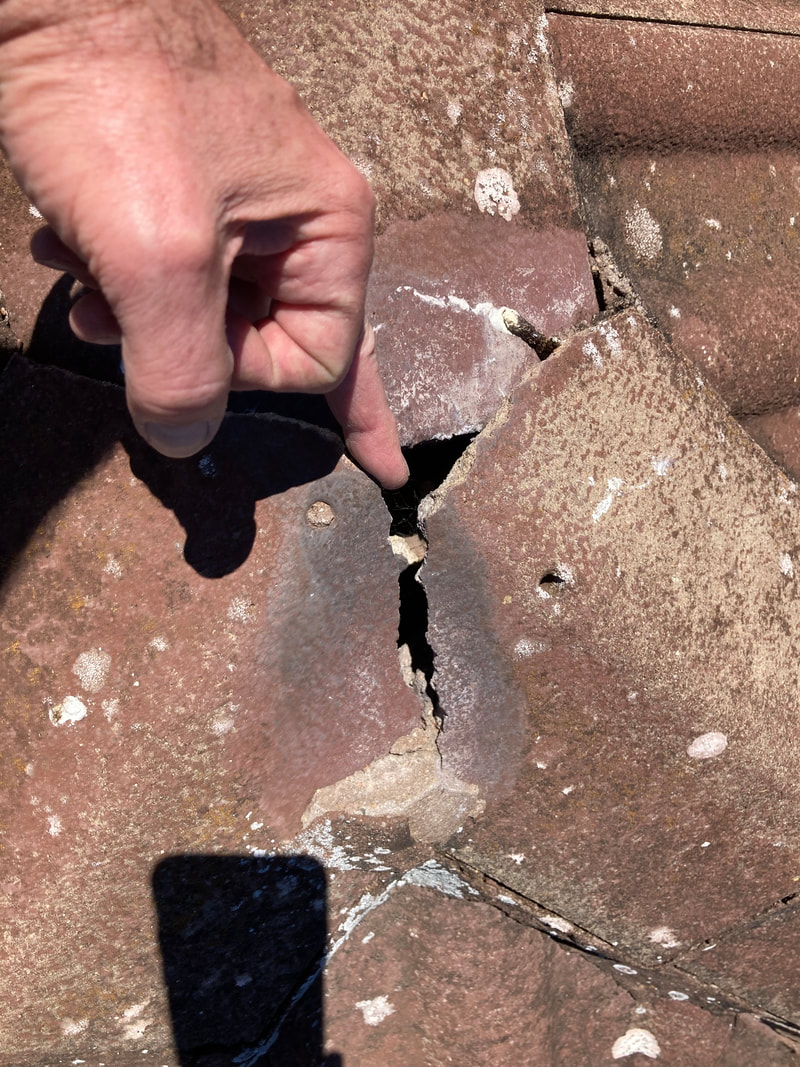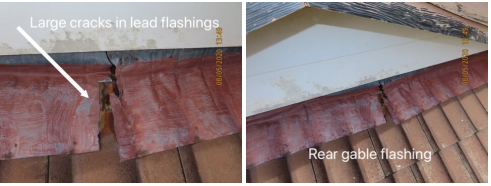| The most common faults are often hidden in the roof cavity or on the house roof itself, however there are many other locations to check. 1. Cracked roofing tiles or cracked roof tile mortar, can cause water damaged ceilings. You can spot the issues by looking for water stained markings and rusted nail staining, sagging ceiling linings or collapsing ceilings. 2. Split lead flashings or sagging lead apron flashings on tiled roofing, especially look around the gable flashings, also will cause the same issues as above (1.), you just need to look at the roof profile to see where the leaks could be coming from. A building inspector will then examine the roof itself and ceiling space to check the damage. The issue is most people selling will paint everything to look nice, so it sells. So unless you have an inspection done you may not know. 3. Insulation often is not installed in older houses, resulting in expensive heating and cooling costs. An issue easily rectified but at a cost you may not have budgeted for. 4. Moisture transfer from bathroom damaged tiles and grouting issues. Grout is only waterproof for around 8 years, then breaks down due to chemical reactions with hair cleaning products and cleaning agents. Often the grout then simply washes away, cracks or falls out, resulting in moisture transfer to areas outside of the shower alcove. Moisture is often seen in the walls opposing the shower, such as the hallway, a building inspector will see this by either looking at the powdering of the solid wall render, or with a moisture meter on both gyprock or solid plaster walls. Bathroom wall and floor junction sealant also has a limited life, as it can peel or lift allowing mould and moisture ingress behind the tile surface. 5. Moisture due to poor ventilation under strip footing type homes, can result in major rising damp issues. As can rising damp issues caused by poor drainage away from the dwelling itself or damaged plumbing. A good building inspector will use a thermal camera or a moisture meter to investigate areas of concern, so in your report it will show not only the area of concern, but the reason for the issue. This then gives you some idea of what is required to rectify the issue. Slab floor newer houses have similar issues concerning moisture but most issues are plumbing related, or bathroom related. 6. Wood rot is common to timber fascias, due to leaking gutters or the use of modern LOSP timbers that have not been adequately sealed or re-treated after cutting. I have seen houses less than 10 years old with serious rot issues. Wood rot is common on fences with timber rails, old timber pergolas constructed with oregon and especially on timber window or door frames. 7. Termite damage is often located in damp timber, located under the house, however once they have entered the house, termites will keep feeding, working up through wall frames into the roofing timbers. Unfortunately the builders original pest spray will only work for around 8 years at best. It is recommended to have yearly inspections. If when looking at a house you notice round disks located in the garden, these are termite traps or inspection traps. You may find drill holes that have been filled with coloured grout around the perimeter of the house. This is where spray has been used prior. Sometimes you may note an area around the house, where the paving has dropped, this was where the trenching was dug for treatment around the exterior of the house. Any treatment should have a Durability Notice left at the house, often placed inside the power box lid to say what chemicals were used and when further treatment is required. 8. Settlement cracking is often located around doors and windows of both gyprock and brick walled houses. Gyprock cracking is often easily rectified by replacing the board linings, or just patching over and painting if minor. House brickwork cracking however can be an issue when brickwork may require removal and the wall rendered over again or even underpinning to lift the house by the footings back to the required levels to close up the wall cracks. 9. Cabinetry damage due to moisture ingress or just years of use. Common bathroom cabinets are constructed from cheap chipboard type materials that are prone to swelling and falling apart in a damp environment. Kitchen cupboards and bench tops also are easily damaged with water from the sink or leaking back splash areas. Black mould can grow in these damp areas, as can the area be conducive to termites activity. 10. Paint finishes are a minor issue, that on a recently painted house may be hiding many other issues. Paint can cover over black mould, rising damp, termite damage, wood rot, just to name a few things that would be expensive to rectify. So this list should assist you in your search for your next home, but I would recommend that you choose a quality building and pest inspector, who has the opportunity to spend 90 plus minutes at the house, not just the 20 mins you had to look around. A good building and pest inspector will use tools such as a thermal camera, moisture meter, termatrac radar unit, cavity camera, ladders to gain access to areas of concern, high power torches etc. and the years of experience required to know what they are looking at when they see an issue, so it can be recorded |
|
0 Comments
Put simply, a thermal camera is a non-invasive tool that simply shows temperature variations, often caused by heat, dampness and dryness. As a building Building inspector I am looking for issues, such as damaged plumbing caused dampness or leaking wet areas such as from roofing and bathrooms. Not every report will include these photos, unless issues are found that need to be explained. Photos help to explain issues better than words alone. Often most houses will have insulation gaps, that will result in poor thermal efficiencies that cause additional heating or cooling costs. These are shown in most reports if an issue is found. Overloaded wiring caused heat signatures can be found on fuse boards, thermography can alert you of this dangerous wiring issue. The variances in temperatures are shown in colours, cool is purple or black, while hotter is yellow or white. Thermal cameras can even detect the location of wall framing or missing wall framing in structures that have been completed. This is often seen in garage conversions done by DIY house flippers. Unfortunately, due to temperature variations of a house, if a house has been closed up for a long time, the camera will not see any temperature differences and find nothing, as the house is all the same temperature. This is why both a moisture meter and a thermal camera is required when inspecting. Thermal cameras can also be used for assisting in finding termite mudding behind walls and other issues. |
AuthorSteve McLeod Archives
December 2023
Categories |



 RSS Feed
RSS Feed